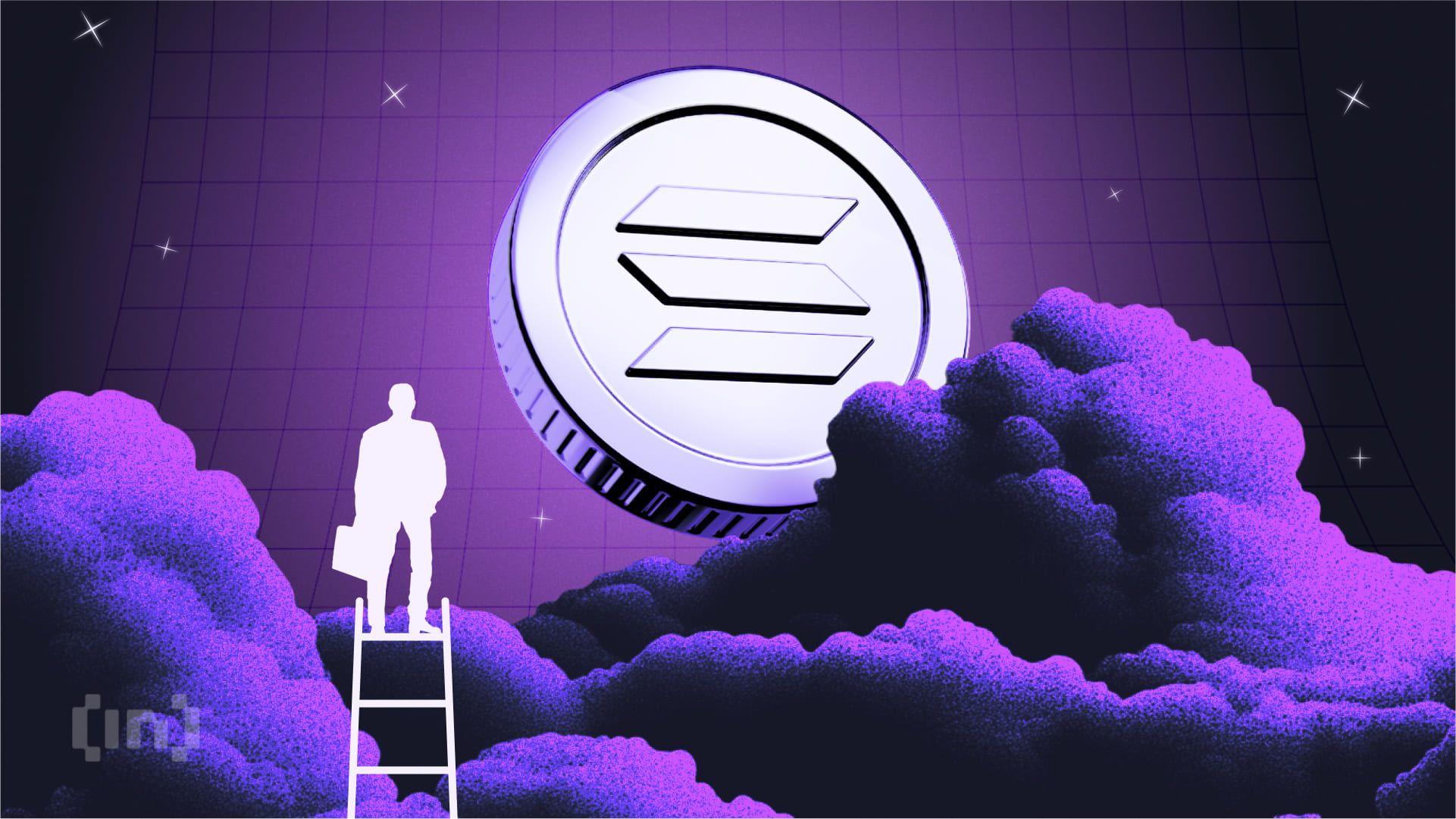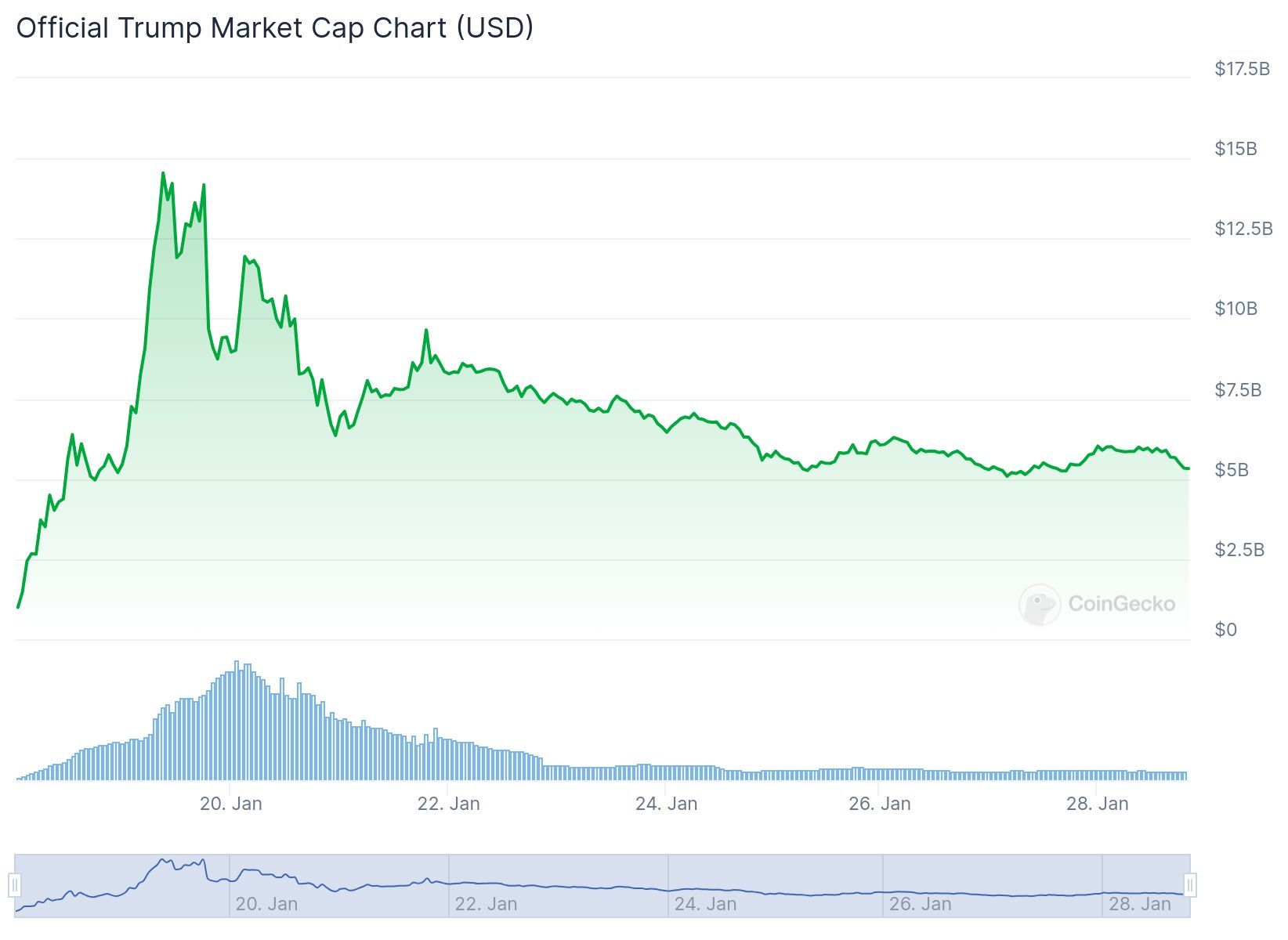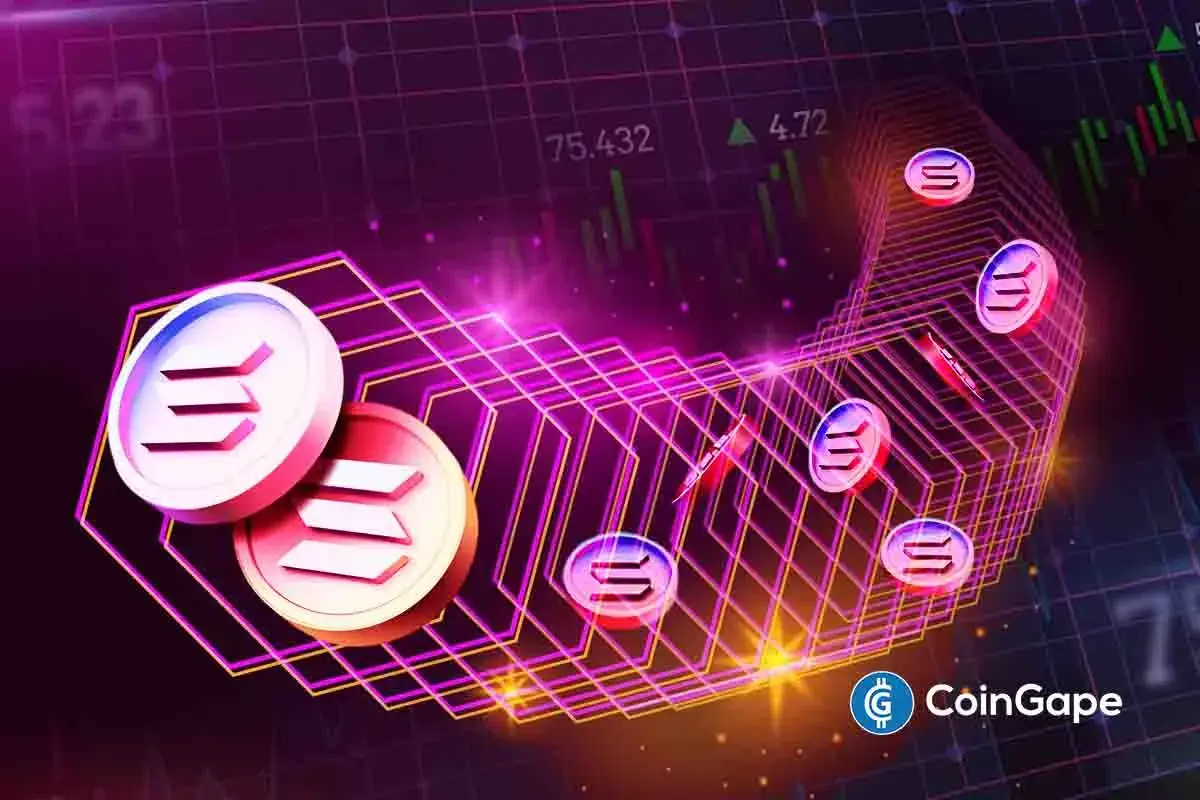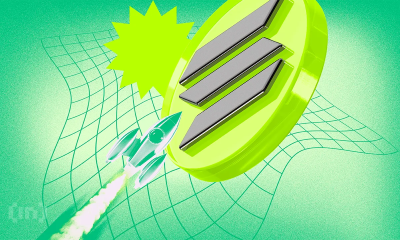Market
Meme Coin Frenzy Highlights Solana dApp Limitations

Shortly before assuming the presidency, Donald Trump launched his own meme coin on Solana. Melania Trump followed suit a day later. Solana faced major congestion issues as millions of users flooded the network to trade the tokens.
In a conversation with BeInCrypto, Chris Chung, CEO of Solana swap platform Titan, said that the bottlenecks stemmed from decentralized applications (dApps) instead of the blockchain itself. The event proved that Solana was ready for mainstream adoption.
TRUMP and MELANIA Break the Crypto Market
Only 48 hours away from taking over the United States presidency, Donald Trump announced the launch of a TRUMP meme coin on his official X and Truth Social accounts.
Within a day of the meme coin’s launch on the Solana network, TRUMP reached a market capitalization of over $14.5 billion and a trading volume of more than $26 billion.

Taking note of the success of her husband’s meme coin, Melania Trump launched her own MELANIA coin a day before Trump’s inauguration.
Shortly after launch, the MELANIA’s market cap exceeded $5 billion. This rapid and sharp spike caused the TRUMP token to drop by $7.5 billion within ten minutes.
It also shook performance across the Solana network.
Users Report Congestion on Solana Amid Increased Traffic
Given the unexpected launch of these presidential tokens, the Solana ecosystem saw a surge in transaction levels as users scrambled to engage in trading. Soon enough, reports of congestion and failed transactions surged across various platforms.
“During the TRUMP launch, the entire Solana ecosystem handled it flawlessly. There were no issues with the block production nor network congestion then, partly due to the meme coin launching at night in North America and uncertainty whether it was real or not. As liquidity was disbursed throughout the network, there were instances of price discrepancies as new pools were added. The issues came when MELANIA launched. With the precedent of TRUMP, extremely large numbers of traders started either rotating into the new token or moved to sell TRUMP with record-breaking volumes,” Chung told BeInCrypto.
Though the unexpected traffic certainly tested Solana’s infrastructure, Chung emphasized that the bottlenecks could be traced back to the decentralized applications (dApps) handling the transaction volumes.
On the day of the MELANIA coin launch, Phantom, a leading wallet provider on Solana, took to social media to inform the public that it was experiencing a strain on its infrastructure.
“We’re currently experiencing a massive surge of 8,000,000+ requests per minute. While we work to stabilize our platform, transactions may have trouble going through on the first try,” the X post read.
Meanwhile, Jito Labs, a key infrastructure provider for the Solana network, reported that its Block Engine API was experiencing “severe degradation” due to the overwhelming volume of transactions.
Most validators on the Solana network use services like Jito Labs, designed to help transactions execute faster. Amid the MELANIA launch, the provider’s degraded performance caused priority fees to go up for the base chain.
“This in itself is the intended mechanism in order to prioritize higher value transactions; however, some applications experienced issues as their max gas fee was no longer high enough for their users’ transactions to land. In addition, the heightened traffic also caused some critical APIs to go down as their services were overwhelmed, which led to some disruptions in the market,” Chung explained.
The increased market demand also hindered the effectiveness of arbitrage bots, which typically help keep prices at bay.
Arbitrage Bots Fail to Stabilize Prices
Arbitrage bots are automated trading programs that play a crucial role in maintaining price stability across cryptocurrency markets.
These bots help ensure prices remain aligned and efficient by identifying and exploiting price discrepancies between exchanges. However, these programs struggled to do their jobs during the increased congestion period following the MELANIA coin launch.
“During the market disruption and congestion, many arbitrage bots were not able to land their own transactions which caused vast discrepancies in prices on certain pools. In particular, we saw some of Titan’s users be able to find pools that allowed them to buy SOL for $150 while the market price was $250. This resulted in many more transactions being submitted to try to take advantage of these arbitrage opportunities, thus causing even more congestion,” Chung said.
In response to the increased trading volumes, the Solana blockchain suffered.
The Solana Network Shows Resilience
The significant surge in trading volume on the Solana network, which reached a record high of $10 billion in 24 hours, inevitably placed considerable strain on the ecosystem.
While this high volume of activity resulted in some performance challenges, Chung highlighted that the Solana blockchain remained operational throughout the period.
The event demonstrated the network’s resilience by continuing to process transactions and maintain network stability despite the reduced performance of Solana-based dApps.
“In fact, the launches were well handled by the blockchain itself. The priority fee mechanism worked as intended, and it was mainly dApps that were having trouble keeping up. It just shows that now is the time for applications and ecosystem participants to upgrade and evolve to be able to handle the future amount of traffic that everyone believes is possible,” Chung said.
Solana has a history of network outages caused by sudden surges in transaction volume, such as those caused by meme coin launches or high trading activity. In 2022, the network experienced up to 14 outages.
However, as the network took proactive steps to increase scalability, these outages became less frequent. The last time Solana experienced a network shutdown was in February 2024.
For Chung, the fact that Solana did not experience an outage after the TRUMP and MELANIA coin launches is indicative that the network is ready for mass adoption.
“With the learnings from the weekend, I believe that Solana is extremely well positioned for a massive increase in user activity as the blockchain itself kept processing transactions under load and increased priority fees as expected,” Chung said.
However, dApps must prepare themselves for when this becomes a reality.
Decentralized Applications Struggle to Keep Pace
For Chung, the main reason Solana users experienced so many issues in trading the presidential meme coins was the inability of dApps to facilitate transactions.
“Many dApps had issues where they had set the max gas fee to a certain pre-set number, so when the gas fees went above this ceiling, the users on these dApps had issues landing transactions as their gas fees were now too low. This then caused users to spam the network even more in an attempt to land a transaction on-chain,” he explained.
While on-chain dApps face fewer obstacles that hinder their ability to handle high transaction volumes, those that rely on external servers face scalability issues.
“dApps, such as aggregators, that rely on their own servers for their products have to ensure that they can handle the projected increase in volume and volatility. This means that extra capacity to handle far more requests and upgrades to dynamically scale depending on user demand will be important going forward, because Solana is likely to see more and more trading activity as it gains mainstream appeal,” Chung added.
Though the launch of the TRUMP and MELANIA coins was unprecedented, as cryptocurrency adoption continues to rise, such events will likely reappear. As a response, decentralized applications that facilitate network transactions must be prepared accordingly.
Strengthening dApp Infrastructure for Future Growth
To avoid repeating similar scenarios in the future, dApps need to revisit their core infrastructure and ensure that it can effectively sustain intense traffic.
“DApps have to plan for their operations to work in worst-case scenarios where multiple components can fail in the pipeline. This means operating with the assumption that the only way to send transactions would be through priority fees and to have reliable backups for critical infrastructure. Although this may mean an increase in expenditure, it is imperative that applications be able to function 24/7 for their users as the blockchain does not stop. In addition, rigorous mechanisms to protect their users have to be enabled if congestion leads to a distortion of information,” Chung said.
These service providers will also need to consider that, as Solana adoption continues to grow, the traffic experienced last week will likely be greater in future scenarios.
“Many dApps had set artificial limits assuming that these would not be breached and external services would keep functioning, but meme coin frenzy showed us a glimpse of what mainstream adoption of cryptocurrencies would look like. To truly build applications where billions can be onboarded, critical infrastructure has to have the ability to keep running,” Chung added.
In the meantime, the Solana network has already laid out the next steps it will take to handle increasingly larger transactions.
Firedancer: A Key Innovation for Solana’s Future Growth
Jump Crypto, a Web3 infrastructure developer, has built a new third-party validator client software for the Solana blockchain for the past two years.
Developed independently from the original Solana Lab’s validator client, Firedancer offers enhanced network resilience by minimizing the risk of widespread outages. By sharing virtually no code, issues within one client will not impact the other. Additionally, Firedancer aims to improve Solana’s transaction processing capabilities significantly.
While Firedancer currently only operates on the Solana testnet, it is expected to launch on the mainnet sometime this year.
“The most eagerly anticipated upgrade of Solana would be the Firedancer client that is set to be released with massive improvements to the amount of transactions per second that the network will be able to handle. It promises to process up to 1 million transactions a second – far more than traditional payment networks. Visa, for example, handles just 65,000 TPS at peak capacity. This is just the next step to making Solana ready for mass adoption,” Chung emphasized.
The launch of the TRUMP and MELANIA coins on the Solana blockchain highlights the growing appeal of the Solana ecosystem within the cryptocurrency market.
Developments like Firedancer will further equip Solana to handle similar events in the future, raising its potential as a preferred platform for individuals and entities looking to engage with cryptocurrencies.
Meanwhile, dApps must ensure they are ready before that moment arrives.
Disclaimer
Following the Trust Project guidelines, this feature article presents opinions and perspectives from industry experts or individuals. BeInCrypto is dedicated to transparent reporting, but the views expressed in this article do not necessarily reflect those of BeInCrypto or its staff. Readers should verify information independently and consult with a professional before making decisions based on this content. Please note that our Terms and Conditions, Privacy Policy, and Disclaimers have been updated.
Market
Report Alleges Massive Meme Coin Sniping on Pump.fun

According to a new report from Pine Analytics, token deployers on Pump.fun systematically funded sniper wallets to buy their own meme coins. This impacted over 15,000 token launches on the platform.
These sniper wallets operated primarily during US trading hours, executing standardized, profitable strategies. Unrelated bot activity obscures their behavior, making it extremely difficult to isolate these wallets—and they can readily adapt to new countermeasures.
Snipers Roam Free on Pump.fun Meme Coins
Pump.fun has remained one of the most popular meme coin launchpads on Solana despite persistent controversies and other criticism.
However, Pine Analytics’ new report has uncovered a new controversy, discovering systematic market manipulation on the platform. These snipes include as much as 1.75% of all launch activity on Pump.fun.
“Our analysis reveals that this tactic is not rare or fringe — over the past month alone, more than 15,000 SOL in realized profit was extracted through this method, across 15,000+ launches involving 4,600+ sniper wallets and 10,400+ deployers. These wallets demonstrate unusually high success rates (87% of snipes were profitable), clean exits, and structured operational patterns,” it claimed.
Solana meme coin deployers on Pump.fun follow a consistent pattern. They fund one or more sniper wallets and grant them advance notice of upcoming token launches.
Those wallets purchase tokens in the very first block and then liquidate almost immediately—85% within five minutes and 90% in just one or two swap events.

Pump.fun meme coin developers exploit this tactic to create the appearance of immediate demand for their tokens. Retail investors, unaware of the prior sell‑off, often purchase these tokens after the snipe, giving developers an unfair advantage. This constitutes market manipulation and erodes trust in the platform.
Pine Analytics had to carefully calibrate its methods to identify genuine snipers. Apparently, 50% of meme coin launches on Pump.fun involve sniping, but most of this is probably bots using the “spray and pray” method.
However, by filtering out snipers with no direct links to developer wallets, the firm missed projects that covered their tracks through proxies and burners.
In other words, the meme coin community does not have adequate defenses against systematic abuse on Pump.fun. There are a few possible ways that the platform could flag repeat offenders and sketchy projects, but adaptive countermeasures could defeat them. This problem demands persistent and proactive action.
Unfortunately, it may be difficult to enact such policies. Meme coin sniping is so systematic that Pump.fun could only fight it with real commitment.
Analysts think that building an on-chain culture that rewards transparency over extraction is the best long-term solution. A shift like that would be truly seismic, and the meme coin sector might not survive it.
Disclaimer
In adherence to the Trust Project guidelines, BeInCrypto is committed to unbiased, transparent reporting. This news article aims to provide accurate, timely information. However, readers are advised to verify facts independently and consult with a professional before making any decisions based on this content. Please note that our Terms and Conditions, Privacy Policy, and Disclaimers have been updated.
Market
Solana Leads Blockchain Metrics as SOL Momentum Builds

Solana (SOL) continues to show strength across multiple fronts, maintaining a bullish structure on its Ichimoku Cloud chart while gaining momentum in key market metrics. The BBTrend indicator has turned higher again, signaling renewed buying pressure after a brief cooldown.
On-chain activity remains strong, with Solana leading all blockchains in DEX volume and dominating fee generation thanks to the explosive growth of meme coins and launchpad activity. With SOL now trading above a key resistance level, the path is open for further upside—though a loss of momentum could still trigger a retest of lower supports.
Solana Maintains Bullish Structure, but Momentum Faces Key Test
On Solana’s Ichimoku Cloud chart, the price is currently above the Kijun-sen (red base line) but has dipped below the Tenkan-sen (blue conversion line), signaling weakening short-term momentum.
The flattening Tenkan-sen and price behavior suggest possible consolidation or the early stages of a pullback. Still, with the price holding above the Kijun-sen, medium-term support remains intact.

The overall Ichimoku structure remains bullish, with a thick, rising cloud and leading span A well above span B—indicating strong underlying support.
If Solana finds support at the Kijun-sen and climbs back above the Tenkan-sen, the uptrend could regain strength; otherwise, a test of the cloud’s upper boundary may follow.

Meanwhile, Solana’s BBTrend is currently at 6, extending nearly ten days in positive territory after peaking at 17.5 on April 14. The recent increase from 4.26 to 6 suggests renewed bullish momentum following a brief cooldown.
BBTrend, or Bollinger Band Trend, tracks the strength of price movement based on Bollinger Band expansion.
Positive values like the current one point to an active uptrend, and if the BBTrend continues to rise, it could signal stronger momentum and potential for another upward move.
Solana Dominates DEX Volume and Fee Generation as Meme Coins Drive Ecosystem Growth
Solana has once again claimed the top spot among all chains in DEX volume, recording $15.15 billion over the past seven days. The combined total of Ethereum, BNB, Base, and Arbitrum reached $22.7 billion.

In the last 24 hours alone, Solana saw $1.67 billion in volume, largely fueled by its booming meme coin ecosystem and the ongoing launchpad battle between PumpFun and Raydium. Adding to this good momentum, Solana recently surpassed Ethereum in Staking Market Cap.

When it comes to application fees, Solana’s momentum is just as clear. Four of the top ten fee-generating apps over the past week—PumpFun, Jupiter, Jito, and Meteora—are Solana-focused.
Pump leads the pack with nearly $18 million in fees alone.
Solana Breaks Key Resistance as Uptrend Targets Higher Levels, but Risks Remain
Solana has finally broken above its key resistance at $136, flipping it into a new support level that was successfully tested just yesterday.
Its EMA lines remain aligned in a bullish setup, suggesting the uptrend is still intact.
If this momentum continues, SOL price could aim for the next resistance zones at $147 and $152—levels that, if breached, open the door to a potential move toward $179.

The current structure favors buyers, with higher lows and strong support reinforcing the trend.
However, if momentum fades, a retest of the $136 support is likely.
A breakdown below that level could shift sentiment, exposing Solana to deeper pullbacks toward $124 and even $112.
Disclaimer
In line with the Trust Project guidelines, this price analysis article is for informational purposes only and should not be considered financial or investment advice. BeInCrypto is committed to accurate, unbiased reporting, but market conditions are subject to change without notice. Always conduct your own research and consult with a professional before making any financial decisions. Please note that our Terms and Conditions, Privacy Policy, and Disclaimers have been updated.
Market
Crypto Firms Donated $85 million in Trump’s Inauguration

According to a new report, 15 firms and individuals from the crypto industry donated more than $100,000 to President Trump’s Inauguration, totaling over $85 million.
Almost all of these companies apparently received direct or indirect benefits from Trump’s administration. This includes dropped legal proceedings, lucrative business partnerships, participation in Trump’s Crypto Summit, and more.
Crypto Industry Went All-In on Trump’s Inauguration
Since promising to bring friendlier regulations on the campaign trail, Donald Trump attracted a reputation as the Crypto President.
Trump’s Inauguration festivities included a “Crypto Ball,” and several prominent firms made donations for these events. Today, a report has compiled all crypto-related contributions of over $100,000, revealing some interesting facts.

Since taking office, President Trump and his family have been allegedly involved in prominent crypto controversies, and these donations may be linked to several of them.
For example, eight of the donors, Coinbase, Crypto.com, Uniswap, Yuga Labs, Kraken, Ripple, Robinhood, and Consensys, had SEC investigations or lawsuits against them closed since Trump’s term began.
The commission might have dropped its probe against these companies anyway due to its changing stance on crypto enforcement. However, being in the President’s good books likely helped the process.
Further Alleged Benefits for Donors
In other words, nearly half the firms that made donations to Trump’s Inauguration have seen their legal problems cleared up quickly. This isn’t the only regulation-related benefit they allegedly received.
Circle, for example, recently made an IPO after openly stating that Trump’s Presidency made it possible. Galaxy Digital received SEC approval for a major reorganization, a key step for a NASDAQ listing.
Other donors, such as Crypto.com and ONDO, got more direct financial partnerships with businesses associated with the Trump family.
Previously, Ripple’s CEO, Brad Garlinghouse, anticipated a crypto bull market under Trump. Also, XRP, Solana, and Cardano were all unexpectedly included in the US Crypto Reserve announcement.
All three of these companies made major donations to Trump’s Inauguration.
It seems that most of the firms involved got at least some sort of noticeable benefit from these donations. Donors like Multicoin and Paradigm received invitations to Trump’s Crypto Summit, while much more prominent groups like the Ethereum Foundation got snubbed.
Meanwhile, various industry KOLs and community members have already alleged major corruption in Trump’s crypto connections.
While some allegations might lack substantial proof, the crypto space has changed dramatically under the new administration, for both good and bad.
Disclaimer
In adherence to the Trust Project guidelines, BeInCrypto is committed to unbiased, transparent reporting. This news article aims to provide accurate, timely information. However, readers are advised to verify facts independently and consult with a professional before making any decisions based on this content. Please note that our Terms and Conditions, Privacy Policy, and Disclaimers have been updated.




















